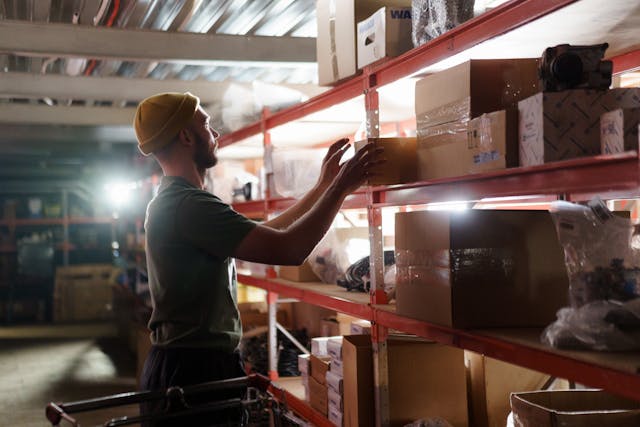
What Actually Happens Between “Order Placed” and “Out for Delivery”
Most people click “buy now,” get a confirmation email, and then just… wait. Maybe they check the tracking link obsessively for the first day or two. But what’s actually happening during those hours or days between placing an order and seeing that beautiful “out for delivery” status? The answer involves way more coordination than most customers realize.
Table of Content
- 1 The Moment Your Order Hits the System
- 2 Inside the Warehouse: More Than Just Grabbing a Box
- 3 The Packing Station Decisions Nobody Thinks About
- 4 The Handoff That Makes or Breaks Shipping Promises
- 5 When Things Don’t Go as Planned
- 6 The Tracking Updates Customers Actually See
- 7 Why This Process Matters for Businesses
The Moment Your Order Hits the System
When someone completes checkout, that order doesn’t just float around in digital space waiting for someone to notice it. It immediately enters a warehouse management system that starts making decisions. The system figures out which warehouse should fulfill the order (if a company has multiple locations), confirms the item is actually in stock, and generates a picking list for warehouse staff.
This happens in seconds. The warehouse team might not physically start working on that specific order right away, but it’s already queued up and prioritized based on shipping method, inventory location, and about a dozen other factors that vary by company.
Inside the Warehouse: More Than Just Grabbing a Box
Here’s where things get more involved than people expect. A warehouse worker gets that picking list and heads to the right shelf or bin location. In a well-organized facility, products are stored based on how often they’re ordered and how they’re usually purchased together. Fast-moving items might be near the packing stations. Seasonal products get shifted around throughout the year.
The worker scans the product barcode to confirm they’ve grabbed the right item. This scanning step matters more than it seems because it updates inventory counts in real-time and creates a digital trail for the entire order. For businesses working with 3pl logistics California providers, this scanning process often integrates directly with their own systems so they can see inventory levels without making phone calls or sending emails back and forth.
Once picked, items move to a packing station. This isn’t just tossing things in a box—there’s actual strategy involved. Packers consider product weight, fragility, and dimensions to choose the right box size and padding. Using a box that’s too large costs more to ship. Using one that’s too small risks damage and returns. Companies obsess over this balance because it directly affects their bottom line.
The Packing Station Decisions Nobody Thinks About
The packing process involves more micro-decisions than most people realize. Should this go in a padded envelope or a box? Does it need bubble wrap, air pillows, or paper fill? If multiple items are in one order, what’s the best way to arrange them so nothing breaks but the package isn’t unnecessarily heavy?
Some warehouses use automated systems that suggest the optimal box size based on the items being shipped. Others rely on experienced packers who’ve developed an instinct for these choices after packing thousands of orders. Either way, these decisions happen fast—good packers can process dozens of orders per hour.
The shipping label gets printed and attached. That label contains way more information than just an address. It includes routing barcodes that tell carrier facilities exactly how to move the package through their network, tracking numbers that update at every scan point, and service level codes that determine priority.
The Handoff That Makes or Breaks Shipping Promises
Getting packages from the warehouse to the carrier is its own operational challenge. Most warehouses have scheduled pickup times with their shipping partners—UPS might come at 4 PM, FedEx at 5 PM, and USPS at 3 PM. Orders need to be packed and ready before those cutoff times, or they miss that day’s pickup and sit until tomorrow.
This is where the “ordered before 2 PM ships same day” promises come from. Companies work backward from their carrier pickup times to figure out their order cutoff windows. If a warehouse needs two hours to pick, pack, and stage orders, and the last truck leaves at 4 PM, then 2 PM becomes the cutoff time for same-day shipping.
Larger operations might have multiple carrier pickups throughout the day or even have dedicated trucks. Some warehouses are located close enough to carrier sorting facilities that they can drop packages off later in the evening and still make the departure deadlines.
When Things Don’t Go as Planned
The process described above is the ideal scenario. Reality includes plenty of complications. Items might be out of stock even though the system showed availability—someone could have just purchased the last one milliseconds earlier. Products might be in the wrong location because of a stocking error. Packing materials run out during busy periods. Shipping label printers jam.
Good warehouses have protocols for all these situations. Out of stock? The system automatically sends a notification and often suggests alternatives. Wrong location? Staff do a quick search of nearby bins or flag it for inventory correction. Equipment problems? Backup systems and manual processes kick in.
The difference between a smooth operation and a chaotic one often comes down to how well a facility handles these inevitable hiccups. The best operations build buffer time into their processes and cross-train staff so bottlenecks don’t paralyze everything.
The Tracking Updates Customers Actually See
Once the carrier scans that package at pickup, customers start seeing tracking updates. But those updates only show specific checkpoints—the package is actually moving through way more steps than appear in the tracking history.
A typical package might get scanned at the warehouse pickup, at the carrier’s local facility, at a regional sorting hub, at the destination city’s facility, when loaded onto the delivery truck, and finally at delivery. Between those scans, it’s been loaded and unloaded from trucks multiple times, moved through conveyor systems, and sorted alongside thousands of other packages.
The “out for delivery” status that everyone waits for means the package has made it through the entire carrier network and is now on a truck heading to its destination. At that point, the warehouse’s job is done—they’ve successfully moved that item from a shelf to the carrier network, and now it’s up to the delivery driver to complete the final step.
Why This Process Matters for Businesses
This whole chain is why fulfillment has become such a massive focus for companies trying to grow. Every single step between someone clicking “buy” and that package leaving the warehouse is a place where things can get delayed, messed up, or cost more than expected. The businesses that really nail this process end up shipping faster and cheaper than their competitors, which matters a lot when customers are comparison shopping.
The businesses that scale successfully are usually the ones that either invest heavily in building these capabilities themselves or partner with specialists who already have the systems and expertise in place. There’s no universal right answer, but there’s definitely a wrong answer: ignoring logistics until customer complaints force the issue.
That gap between “order placed” and “out for delivery” might seem simple from the outside, but it’s packed with decisions, coordination, and operational complexity that directly determines whether customers get their orders on time and intact. The companies that treat this middle step as seriously as product development or marketing tend to be the ones that customers keep coming back to.


